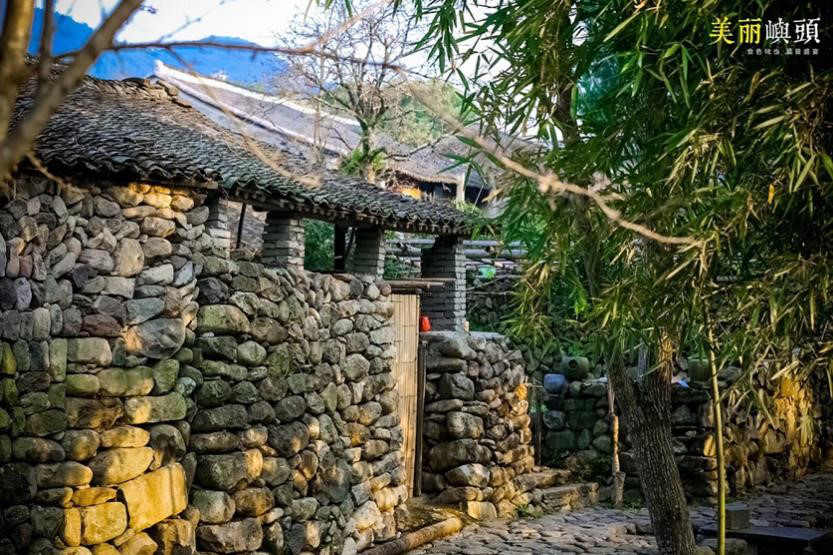


Photo shows the dwellings of residents in Shatan village, Yutou township, Huangyan district, Taizhou, east China's Zhejiang province. (Photo/hyxw.net)
Shatan village, an old village with a history of several hundred years in east China's Zhejiang province, has become a prosperous village through green and eco-friendly development approaches.
As the village was rebuilt at and villagers moved to a different location, the old Shatan village was once at a low ebb in its development as its old streets and houses had gradually decayed.
However, the village, which is located at the upstream stretch of the Changtan reservoir in Huangyan district, Zhejiang province, has been revitalized in recent years.

An aerial view of Shatan village, Yutou township, Huangyan district, Taizhou, east China's Zhejiang province. (Photo/Yutou township)
Typical elements in the old village, such as roads paved with flagstones, ancient camphor trees, and old stage for performances of traditional Chinese opera, have attracted wide attention on the Internet, turning Shatan village into a popular village featuring a tranquil atmosphere and quaint charm.
The popular hotel transformed from an old granary at Shatan village is one of the reasons behind the growing fame of the village.
How popular is the special hotel named “Liang Su” (the name can be translated as “graintel”)?
“You can’t possibly get a room for weekends and holidays if you fail to make a reservation about one month in advance,” said local villagers.
The transformation from granary to a hotel considered not only on making it special and comfortable, but also focus on using green technological solutions, said some tourists.
A staff member of the hotel noted that the transformation project features typical low-energy, multi-function and environmentally-friendly buildings.
The green and waterproof coating material on the walls has helped effectively solved the problem of damp in old buildings, the staff member explained, adding that since the interior walls are made from high-performance thermal insulation materials, people staying in the hotel don’t need air conditioners in summer.
The yard of the hotel has been landscaped and equipped with permeable lawns, and the rainwater collection and utilization system installed on the roofs can purify and then recycle rainwater.

Photo shows a pond surrounded by dwellings in Shatan village, Yutou township, Huangyan district, Taizhou, east China's Zhejiang province. (Photo/College of Architecture and Urban Planning, Tongji University)
In 2013, at the invitation of Huangyan district, a team led by Yang Guiqing, a professor at the College of Architecture and Urban Planning, Tongji University, established a village planning teaching and practice base to help map out a reconstruction plan for Shatan village.
Making the most of existing buildings in the village, Yang's team turned abandoned veterinary station, granary, office building of village committee and other buildings into tourist center, special hotel, tea kiosk and wine workshop.
The renovated buildings have maintained a traditional style, giving local residents a sense of belonging while bringing memories of the past to many tourists.
The diners, bars, libraries, and square for theatrical performances in old times arrayed on both sides of the old street in Shatan village are in harmony.
The outdoor conference center in the village is equipped with facilities that could realize the simultaneous interpretation of multiple languages, reflecting the endeavor of Shatan village to open its door wide and actively explore its development paths.
By inviting Yang's team to reconstruct Shatan village and other old villages, Huangyan district aims to improve the value and competitiveness of rural products through combination of research of universities with rural development while making full use of the projects and funds of the government.

Photo shows the special hotel transformed from granary in Shatan village, Yutou township, Huangyan district, Taizhou, east China's Zhejiang province. (Photo/Yutou township)
Since 2013, Shatan village has effectively combined traditional culture with modern technology in its transformation efforts according to the actual situation of the village and the needs of local villagers, trying to create a living environment that integrates the traditional features of the village and modern scientific and technological elements.
For example, it has comprehensively upgraded the water, electricity, gas, sewage, drainage facilities in the village, thus effectively satisfying residents' needs for living, business and tourism and facilitating the revitalization of the old village.
As more and more visitors come to Shatan village, the income of local residents has also increased.
The per capita annual income of the village has exceeded 100,000 yuan (about $15,303), which makes people in Shatan village more confident and optimistic about the future.
While improving the living environment of old villages and attracting tourists, Huangyan district starts to explore a distinctive new path for rural revitalization. It intends to establish a pattern of rural development that integrates scientific research, education and training with the local culture and ecological environment.

 Award-winning photos show poverty reduction achievements in NE China's Jilin province
Award-winning photos show poverty reduction achievements in NE China's Jilin province People dance to greet advent of New Year in Ameiqituo Town, Guizhou
People dance to greet advent of New Year in Ameiqituo Town, Guizhou Fire brigade in Shanghai holds group wedding
Fire brigade in Shanghai holds group wedding Tourists enjoy ice sculptures in Datan Town, north China
Tourists enjoy ice sculptures in Datan Town, north China Sunset scenery of Dayan Pagoda in Xi'an
Sunset scenery of Dayan Pagoda in Xi'an Tourists have fun at scenic spot in Nanlong Town, NW China
Tourists have fun at scenic spot in Nanlong Town, NW China Harbin attracts tourists by making best use of ice in winter
Harbin attracts tourists by making best use of ice in winter In pics: FIS Alpine Ski Women's World Cup Slalom
In pics: FIS Alpine Ski Women's World Cup Slalom Black-necked cranes rest at reservoir in Lhunzhub County, Lhasa
Black-necked cranes rest at reservoir in Lhunzhub County, Lhasa China's FAST telescope will be available to foreign scientists in April
China's FAST telescope will be available to foreign scientists in April